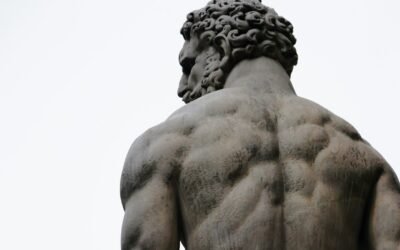Our first article introduced us to how we got to where we are today – with the seeming disconnect between theology and creativity in many churches. We defined what we meant by developing a theology of creativity. We also looked at how this Gospel-shaped theology will be structured by the four main categories of God, Man & Sin, Christ and our Response.
In this second article, we’ll be taking a look at that first category – GOD.
GOD: The Original Creative (Genesis 1 & 2)
Literally, the first thing the Bible reveals to us about God is that He is the Creator – the Creative par-excellence! But how does Genesis 1 help us understand creativity?
If we hope to understand creativity, we must look at its origins. It doesn’t get more original than the Originator Himself! We’ll take a fresh look at Genesis 1 to see what the text shows us about the Original Creative. God’s world demonstrates His creativity while God’s Word interprets it for us – so now, we turn to His word.
God as Creative
Many Christians today, when they hear of Genesis 1, they think “Oh yea, that’s where God creates the universe out of nothing.” And they would be correct… in part. Genesis 1 is about creation ‘ex-nihilo’ (out of nothing), but to boil it down to only that would be to miss the forest by straining at a leaf.
Look closely at Genesis 1 and you will see that the words “God created” doesn’t really occur as much as you may think. In fact, they occur only in 3 verses in the whole chapter:
- Verse 1 – as an overall summary statement: “in the beginning, God created… everything”
- Verse 21 – with the first mention of the creation of all animal life.
- Verse 27 – with God’s special creation – mankind in His image – which we will get back to.
Now, don’t get me wrong – I’m not saying that Genesis 1 isn’t about Creation – just that we can tend to gloss over a text because we think we already know what it says. Let’s look and read carefully. For the majority of Genesis 1, we don’t really read much of God ‘creating’… at least not in the sense that we can tend to assume. Let’s look closely at the text – what is God described as doing?
Organizing and Filling
Firstly, we might be surprised to see that in verse 2, there is already this ‘formless earth’. What follows for the majority of verses 3-19, on Days 1 to 3, is a lot of God ‘separating’ various aspects of the environment: the skies, waters, light and dark… it’s almost like God is putting the ‘formless, chaotic earth’ into order. The raw materials are already there, they’re just without structure and purpose. God orders them by separating them into their proper places, and then He names them.

From verse 20 to the end of the chapter, we see God starting to fill the now organized and prepared environments from Days 1 to 3 with the things that inhabit them. He creates the Sun, moon and stars which inhabit the heavens, he creates birds and sea creatures to inhabit the seas and skies, then he creates the land animals and man to inhabit the land. He also gives each of these creatures a command or purpose to fulfill within their spaces. Also, something interesting we see on Days 4 to 6 in contrast to 1 to 3 is that God no longer names things after he has created them – because that responsibility will be given to Adam later.
So, what do we learn about God as Creative?
We learn that His creativity is about bringing order, structure, and purpose to the disordered, formless raw materials. There is a natural logic to His creation – He makes the environments and prepares them for the creatures He will later make and put in them.
God’s creativity brings His order and purpose.
Defining Beauty | God the Primary Viewer
What is one of the repeated phrases throughout the creation narrative? “God saw that it was good.”
Notice, this is not just a pragmatic declaration, as in – everything functioned as it ought – but also an aesthetic pronouncement. How do I know this? Because when Genesis 2 retells the story, in verse 9 it clarifies that the plants God made to spring up were “pleasant to the sight and good for food.”
In Genesis 1, six times we see the phrase “God saw that it was good” and the seventh time, “God saw everything that he had made, and behold, it was very good.” By the seven-fold repetition of the phrase, it re-emphasizes the completeness of everything He made and ‘sees’ – then the call to “behold” grabs the reader’s attention to say, “HEY YOU! Look closely at this here!” And what is God’s verdict of all that He sees? It is not just good, but VERY GOOD!
Beauty is in the eye of the Beholder
Also notice that God is the primary viewer. He is the one who sees and then declares it as good. God defines what is good. This is important to remember in building our theological understanding of beauty and aesthetics. God is always the primary viewer. And thus, even when we ask the question, “What is good art or creativity?” it is an essentially theological question.
David Covington, in researching his book – “A Redemptive Theology of Art” – said:
“The Bible said little about art per se but a fair amount about craft and design and forms. It said very little about songwriting while giving me many examples of the craft-but much about beauty, picture language, and images… The more I looked, the more I noted that forms and images, art and beauty, distortion and ugliness always appeared in context; they always had an observer, a seer. And that was God himself.” (pg. 29)

Creation’s goodness is derived from the good God who created it, and because He alone can fully perceive all of it – all the billions of stars and galaxies far too vast for humans to comprehend fully – He alone fully appreciates it. Creation’s beauty, truth and power, consists first in the eye of God as the first and eternal Beholder.
The saying is true, that beauty is in the eye of the beholder… however, we must understand, that Beholder is God.
Note also, in Genesis 1, that God does not say “behold” to any other creature before Man – the previous six times God saw His creation and said it was good, there is no ‘behold’ beckoning some other ‘beholder’ to look. The first two uses of the word ‘behold’ in scripture immediately follow God’s creation of people and are addressed to them. As image-bearers of God, they are commanded to image Him in their ‘beholding’ – their ‘seeing’ of the goodness of creation.
The Tabernacle | Exodus
Many other Biblical examples could be given of God’s concern for beauty, but here is one from Exodus that can quickly illustrate that God is not uninterested in beauty and creativity.

In Exodus 25:18, God commands that two cherubim are to be made of gold for the Art of the Covenant. Cherubim are angelic hosts – and what is commanded is some sort of representational art – which it seems that the artist was given creative liberty (within certain bounds to create). In Exodus 28 and 29, where we find instructions surrounding the tabernacle – the primary place where God’s OT people were to meet with God’s presence – we see that the priestly garments were designed and worn “for glory and for beauty” (Ex. 28:2) and the burnt offering was a “pleasing aroma.” (Ex. 29:18) The garments were to have blue and purple pomegranates – nowhere in nature do we find blue and purple pomegranates. It seems like the art that God commands is not necessarily always ‘photographic’ representations of reality but involve some creative imaginations too! Furthermore, God said that He had filled Bezalel with the Spirit which enabled him to devise artistic designs in precious materials and crafts for the Tabernacle (see Exodus 36:1-4).
See that? Spirit-filled creativity to the glory of God!
“God restricts the use of the special anointing oil and the incense to his audience alone (Ex.30:32, 37). God reserved to himself the pleasure of these special symbols; he forbade his people to use them for private, personal pleasure, though other formulations of oil and of incense were expected and not forbidden. By this restriction, God reminded the Israelites that he alone is the first viewer, the one whose pleasure has primacy.” (Covington, A Redemptive Theology of Art, 94)
But note again – who is the primary beholder of these beautiful things? God was the primary audience of the priest’s garments, the burnt offering, the oil and incense, and the crafted designs of the Tabernacle. God’s people were invited in to share in this beautiful vision of the sacred space. All of these details of the creativity that went into the Tabernacle are given not for utilitarian purposes or pragmatism – what pragmatic purpose was there to blue pomegranates!? Rather it shows us that God wanted beauty in the place that represented His presence, and where His people gathered to worship.
Now, we must bear in mind there is a difference between the Old and New Testaments. We no longer live under the Old Covenant. That’s no longer our Covenant since Jesus Christ has come and ushered in a new and better covenant. But they are our Scriptures, and I do think they teach us something of God and His delight in the aesthetic and beautiful.
The very fact that in the Bible we have creativity on display in the text itself (we have poems, chiastic structures, songs, metaphors, etc.) and we believe that the text is God-breathed (inspired by God himself) shows that God is concerned and pleased with the use of creativity and wants us to see and appreciate it with Him. As John Calvin said,
“All the arts come from God and are to be respected as divine inventions.”
We are invited into sharing in God’s seeing and appreciation of beauty and goodness.
I hope that this whetted your appetite for a taste of how we can draw from what the Bible tells us about God as Creator to inform our understanding of creativity as Christians. Next, we will seek to start understanding what exactly is beauty itself in relation to God. How does theology help us understand aesthetics?
Please consider liking, commenting and/or sharing if you’ve found this interesting or helpful.
Articles in this series:



